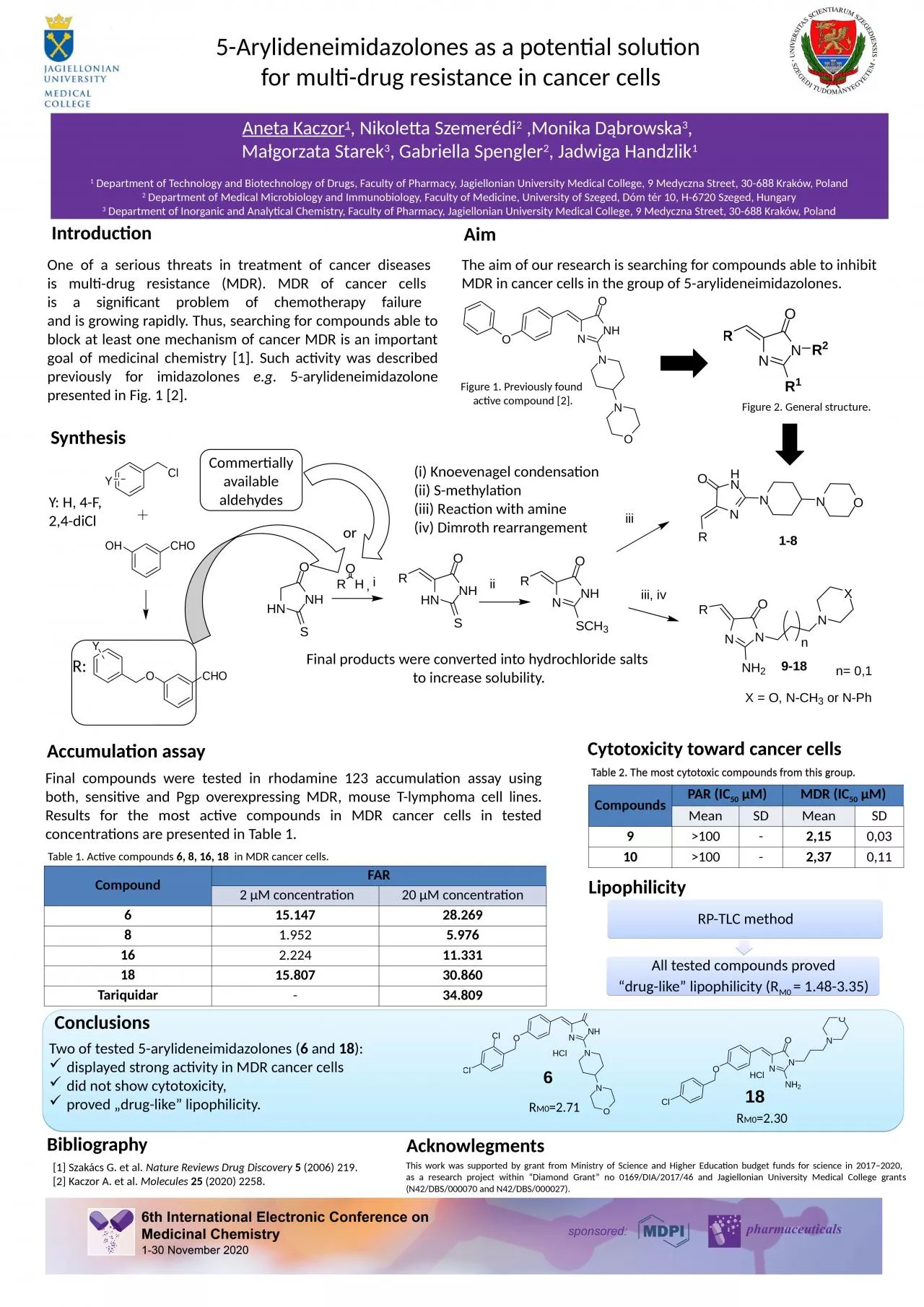

for multidrug resistance in cancer cells Aneta Kaczor 1 Nikoletta Szemerédi 2 Monika Dąbrowska 3 Małgorzata Starek 3 Gabriella Spengler 2 Jadwiga Handzlik 1 ID: 935292
Download Presentation The PPT/PDF document "5-Arylideneimidazolones as a potential s..." is the property of its rightful owner. Permission is granted to download and print the materials on this web site for personal, non-commercial use only, and to display it on your personal computer provided you do not modify the materials and that you retain all copyright notices contained in the materials. By downloading content from our website, you accept the terms of this agreement.
Slide1
5-Arylideneimidazolones as a potential solution
for
multi-drug resistance in cancer
cells
Aneta Kaczor1, Nikoletta Szemerédi2 ,Monika Dąbrowska3, Małgorzata Starek3, Gabriella Spengler2, Jadwiga Handzlik11 Department of Technology and Biotechnology of Drugs, Faculty of Pharmacy, Jagiellonian University Medical College, 9 Medyczna Street, 30-688 Kraków, Poland2 Department of Medical Microbiology and Immunobiology, Faculty of Medicine, University of Szeged, Dóm tér 10, H-6720 Szeged, Hungary3 Department of Inorganic and Analytical Chemistry, Faculty of Pharmacy, Jagiellonian University Medical College, 9 Medyczna Street, 30-688 Kraków, Poland
Introduction
One of a serious threats in treatment of cancer diseases
is
multi-drug resistance (MDR). MDR of cancer cells is a significant problem of chemotherapy failure and is growing rapidly. Thus, searching for compounds able to block at least one mechanism of cancer MDR is an important goal of medicinal chemistry [1]. Such activity was described previously for imidazolones e.g. 5-arylideneimidazolone presented in Fig. 1 [2].
Aim
The aim of our research is searching for compounds able to inhibit MDR in cancer cells in the group of 5-arylideneimidazolones.
Synthesis
Final products were converted into
hydrochloride
salts
to
increase
solubility.
(i) Knoevenagel condensation (ii) S-methylation (iii) Reaction with amine (iv) Dimroth rearrangement
This work was supported by grant from Ministry of Science and Higher Education budget funds for science in 2017–2020, as a research project within “Diamond Grant” no 0169/DIA/2017/46 and Jagiellonian University Medical College grants (N42/DBS/000070 and N42/DBS/000027).
Two of tested 5-arylideneimidazolones (6 and 18):displayed strong activity in MDR cancer cellsdid not show cytotoxicity,proved „drug-like” lipophilicity.
Accumulation assay
Cytotoxicity toward cancer cells
Lipophilicity
Acknowlegments
Bibliography
R:
Y: H, 4-F, 2,4-diCl
Compounds
PAR (IC
50
µM)
MDR (IC50 µM)MeanSDMeanSD9>100-2,150,0310>100-2,370,11
Table 2. The most cytotoxic compounds from this group.
Final compounds were tested in rhodamine 123 accumulation assay using both, sensitive and Pgp overexpressing MDR, mouse T-lymphoma cell lines. Results for the most active compounds in MDR cancer cells in tested concentrations are presented in Table 1.
CompoundFAR 2 µM concentration 20 µM concentration 615.14728.26981.9525.976162.22411.3311815.80730.860Tariquidar-34.809
Conclusions
Table 1. Active compounds 6, 8, 16, 18 in MDR cancer cells.
Figure
1.
Previously
found
active compound [2].
Figure 2. General structure.
[1] Szakács G. et al. Nature Reviews Drug Discovery 5 (2006) 219.[2] Kaczor A. et al. Molecules 25 (2020) 2258.
Commertially
available aldehydes
or
RM0=2.71
R
M0
=2.30